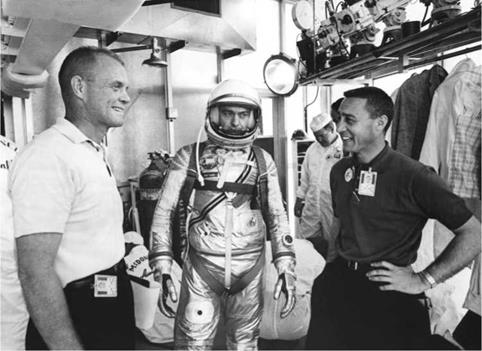STEPPING UP THE TRAINING
Much to the frustration of the media, waiting for news of the astronaut selected to make the first space flight that year, NASA would only announce that of the original seven, only three – John Glenn, Gus Grissom and Alan Shepard – had been selected as prime candidates for the first Mercury-Redstone mission, and the name of the man who would fly would not be revealed until nearer the time. The other two, as well as the remaining four men, would fly later space shots.
For Glenn and Grissom, and particularly Shepard, the training was stepped up to prepare them for that first, crucial flight. Shepard would find the pace particularly grueling at times.
“Early in 1961, the Cape, as it was simply called, was the most exciting place in the country. It was also a very tough place to work. Despite the glowing press reports about how well things were going with the astronauts and the Mercury operations team, the reality was that conflict was a part of everyday life at Cape Canaveral. Arduous project schedules and the long wait to get up into space made us feel stifled and resentful.”
And then there was the matter of a primate making a suborbital flight ahead of an astronaut.
|
Until the flight was imminent the press and public would know only that the nation’s first astronaut would be selected from John Glenn, Alan Shepard, and Gus Grissom. (Photo: NASA) |
“The irony of playing second fiddle to a chimpanzee was particularly galling to us,” Shepard noted. “NASA had decided to send a chimp into space before sending me. I protested again and again, but NASA insisted the little ape go first. The agency meant well. But all I could think about were Russian boosters rolling to their pads for the first manned space flight.
“There were other frictions too. At the Cape I spent most of my time in a ‘procedures trainer.’ This was a replica of the actual spaceship that would boost me more than one hundred miles into space. It also duplicated the severe semi-supine flight position, with the pilot lying on his back, legs vertical to the knees and then dropped down so that he was shaped like a squared-off pretzel. No one liked the trainer. It was like taking a straight-backed chair, placing it on its back, and then ‘sitting’ in it. This is where the astronaut trained to reach all his instruments and controls until he could go through every motion of his scheduled flight with his eyes closed and never miss hitting the right button or lever.
“By late January events were coming down to the wire. As flight time neared, the practical joking that had helped keep us all sane faded away. A serious tone settled over the launch, support, flight, and recovery teams. Redstone, the booster rocket, was working well, and I was scheduled to be launched in about six more weeks.” [33]











